Stitched trial samples for Resolved Sample
Fabric manipulation method
Image 12.1 – Butter muslin gathered in a wavy line with black crochet cotton
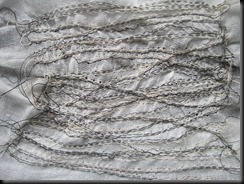
Image 12.2 – Butter muslin stitched with triple needle using black, cream and multi coloured thread.

Image 12.3 – Butter muslin stitched with wide double needle with wool trapped on reverse

Image 12.4 – Butter muslin stitched with vertical and horizontal pin tucks and then pressed open.
Hand stitching method

Image 12.5 – Chevron stitch worked on calico using embroidery thread, cotton thread, thick cotton thread, black and white crochet thread and beige knitting cotton.
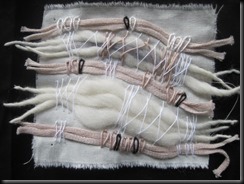
Image 12.6 – Fancy wool and cream ribbon couched on calico using Cretan and detached chain stitches.

Image 12.7 – Back stitch worked on calico and then woven loosely with black and white crochet cotton and beige knitting cotton.

Image 12.8 – Chain stitch worked on calico with a variety of sized stitches using white embroidery thread, black and white crochet thread and beige knitting thread.
Combined fabric manipulation plus hand stitching
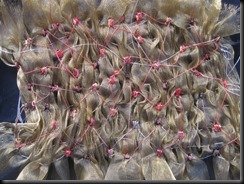
Image 12.9 – Satin stitch worked on gathered organza in a variety of embroidery thread colours .

Image 12.10 – Chevron stitched worked in a variety of sizes using white cotton, black and white crochet thread and beige knitting cotton on gathered butter muslin.

Image 12.11 – Pin tucks worked on white linen and fixed in place in opposite directions using feather stitch worked with varigated perle and black crochet cotton.

Image 12.12 – Chevron stitch using pale green and variegated perle on gathered grey organza layered with gold net.
As a reminder this is my chosen design shape

Using MS Publisher I have now experimented with three options – one using a plain background and the other with the double pintuck as a background. A gap would be left between each shape to show the background.
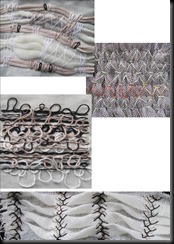

Option One and One a


Option Two and Two a
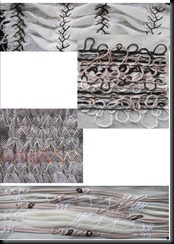

Option Three and Three a
Whether I use the plain background or the pintuck background I would work the four main shapes on Vilene and attach after giving a raised effect.
I really like the pintuck background because it joins the individual shapes together so my current favourite would be Option Two a.
I chose to create the samples using natural colours but I do wonder if I need to introduce some colour – if I used similar colours perhaps I could add some colour at a later date if necessary.
I like the mixture of fabrics, the soft butter muslin, the organza/net, the calico and the linen and hopefully as the butter muslin is pintucked horizontally and vertically it will be strong enough to support the individual shapes when they are attached.















